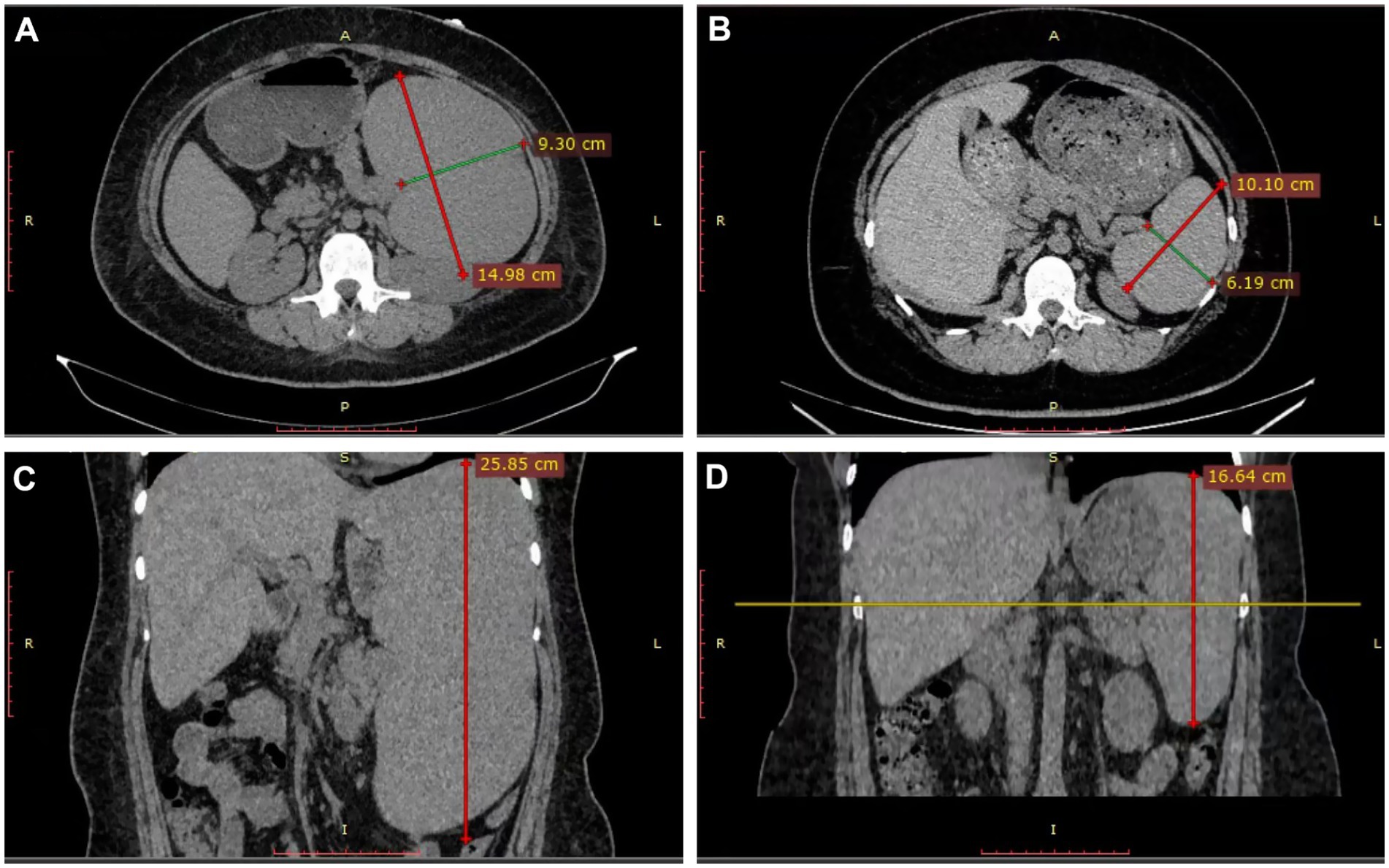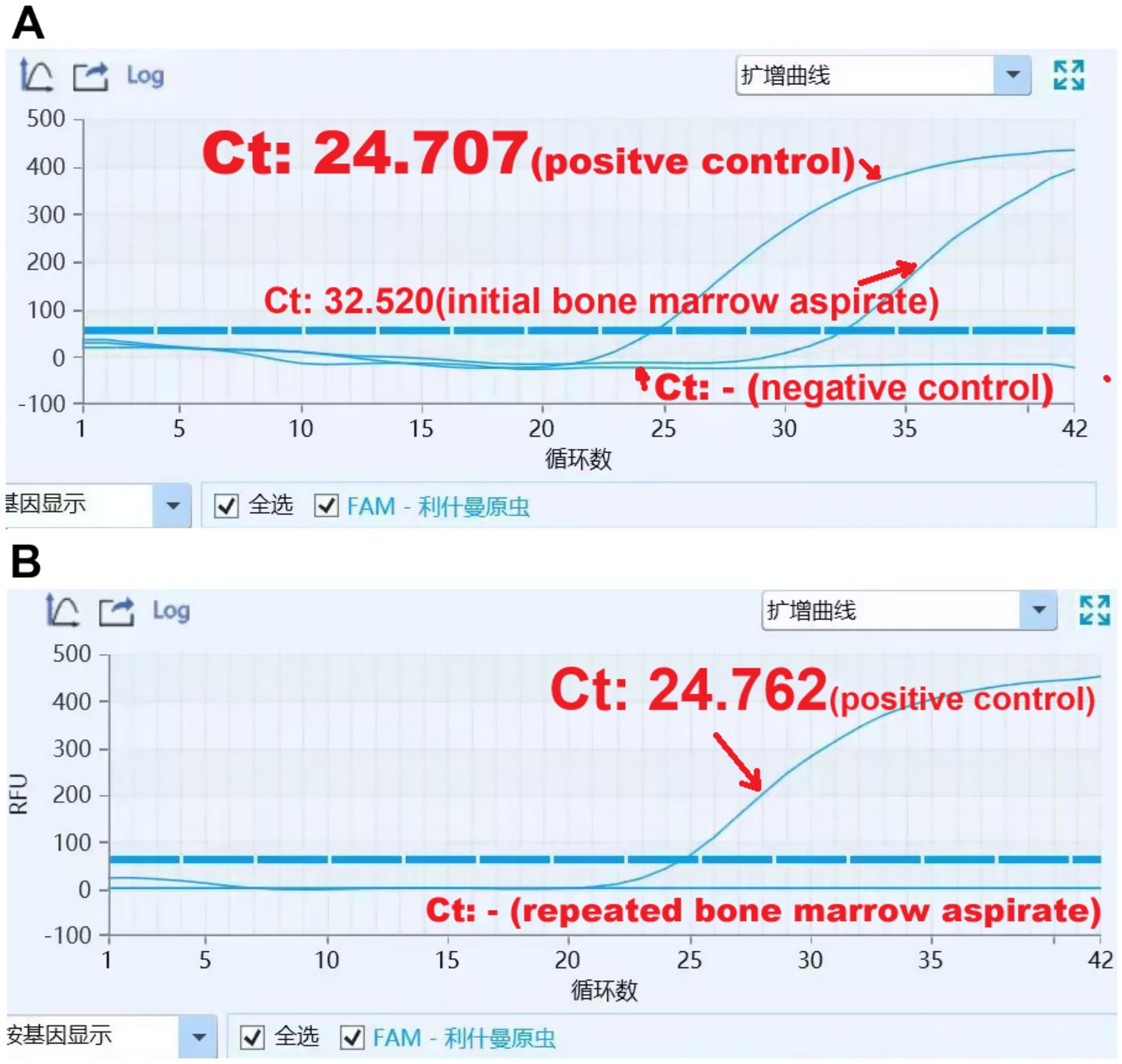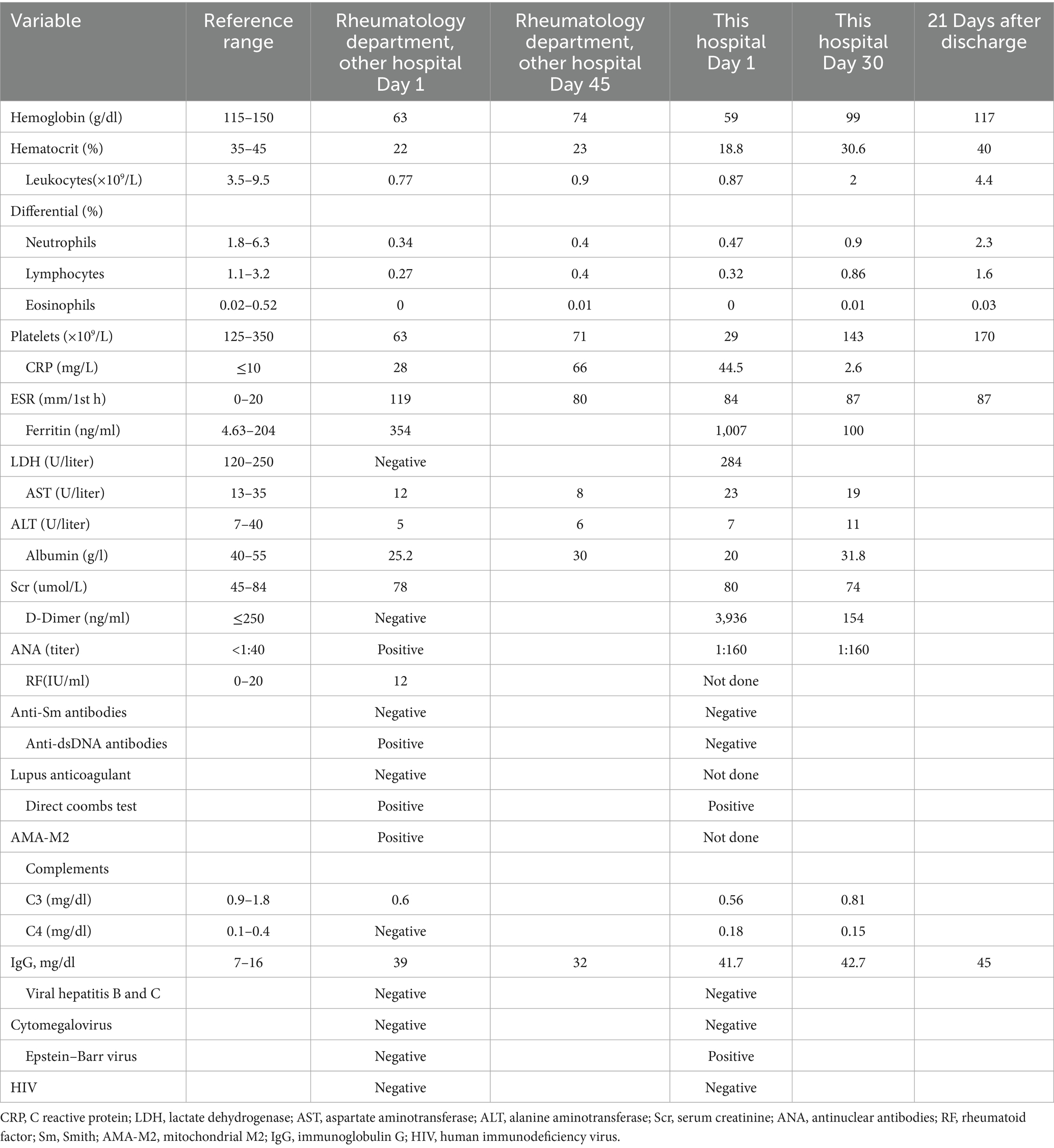- 1Department of Infectious Diseases and Center for Liver Diseases, Peking University International Hospital, Beijing, China
- 2Department of Infectious Diseases, Peking University First Hospital, Beijing, China
Visceral leishmaniasis (VL), also known as kala-azar, is an often-neglected tropical disease caused by Leishmania donovani. It is endemic in certain regions of China, including Shanxi Province. This case report describes a 36-year-old female migrant worker who regularly travels between Shanxi Province, her hometown and Zhongshan, Guangdong Province. She presented with prolonged fever, splenomegaly, pancytopenia and high title anti-nuclear antibodies. She was initially diagnosed with systemic lupus erythematosus (SLE) and associated polyclonal gammopathy. Her condition failed to improve with corticosteroids and immunosuppressants. Further evaluation revealed VL, confirmed by bone marrow smear and molecular testing. Treatment with liposomal amphotericin B led to prompt clinical resolution. This case highlights the importance of obtaining travel history and considering parasitic infections in patients with refractory fever and splenomegaly.
1 Introduction
Visceral leishmaniasis (VL), a protozoan infection caused by Leishmania donovani complex, represents a life-threatening tropical disease with over 95% mortality rate in untreated cases and an estimated 50,000 to 90,000 new cases occur annually worldwide (1, 2). While the classic triad of chronic fever, pancytopenia, and hepatosplenomegaly can be revealing in endemic regions, these findings can also occur in systemic lupus erythematosus (SLE) (3–10). Moreover, active VL’s ability to mimic SLE by producing antinuclear antibodies (up to 82% in recent series) and other autoantibodies in active VL (11) contributes to the overlap between these two disorders and diagnostic pitfalls. We present an illustrative case representative of a group of population, namely migrant worker, who regularly travels between Shanxi Province, China, a well-documented endemic region for VL (12) and her workplaces, Zhongshan, Guangdong Province, where VL is rare. Substantial descrepancies in febrile disease spectrum between endemic and non-endemic areas, poor coverage of routine laboratory studies for leishmaniasis, failure to ellucidate full travel history, as well as over-reliance of auto-antibody positivity might contribute to the diagnostic delay. The patient’s 9-month diagnostic odyssey, involving multiple, escalating immunosuppressive regimens with subsequent clinical deterioration, underscores the vital importance of detailed travel history, knowledge of VL as a “great masquerader” in autoimmune-like presentations and targeted parasitological evaluation in chronic febrile pancytopenia patients unresponsive to corticosteroids.
2 Case presentation
A 36-year-old woman migrant worker from Shanxi Province, working and residing in Guangdong Province with her husband, presented with a 9-month history of fever, fatigue, joint swelling and weight loss. Other medical history is unremarkable except a 4-year history of untreated asthma. She denied contact with animals or febrile patients. Her husband have been otherwise healthy. No family history of susceptibility to recurrent infection were documented. She was initially evaluated at a local hospital in Zhongshan City. Laboratory tests revealed hemoglobin of 91 g/L, white-cell count of 2 × 10^9/L, platelet count of 73 × 10^9/L, elevated inflammatory markers [C-reactive protein (CRP), 35 mg/L; erythrocyte sedimentation rate (ESR), 59 mm/h; ferritin, 256 ng/mL], and positive antinuclear antibodies (ANA, titer 1/320) and anti-mitochondrial antibodies (AMA-M2). Serum IgG was markedly elevated at 53 g/L. Liver, renal functions and Immunofixation Electrophoresis (IFE) of Blood and Urine were normal. Bone marrow examination reportedly revealed hypercellular marrow with erythroid hyperplasia, with no evidence of malignancy or parasites. Abdominal computed tomography revealed hepatosplenomegaly. Her symptoms worsened, and she subsequently experienced high spike fever up to 40°C, profound fatigue, and significant weight loss. She was admitted to a rheumatology department in a tertiary hospital. Laboratory results confirmed pancytopenia, polyclonal gammopathy, and more importantly, revealed multiple auto-antibodies (ANA, titer 1:320, anti-dsDNA and anti-PM-Scl antibodies), positive direct Coombs test (DCT) and hypocomlementemia (low serum C3 and C4 level) (Table 1). Abdominal ultrasound reported hepatosplenomegaly, with the spleen measured 25 cm at long axis. Repeat bone marrow smears and biopsy showed no further diagnostic clue, reportedly. A presumable diagnosis of SLE was made. She then received high-dose glucocorticoids, cyclosporine, hydroxychloroquine, tofacitinib, and telitacicept (a BLyS/APRIL inhibitor). But her fever persisted with low level grade and pancytopenia showed minimal improvement. Ten days after self-discontinuation of prednisone (previously tapered to 20 mg daily) and cyclosporine (50 mg twice daily), the patient developed recurrent high spike fever, prompting her to our department. After reviewing her disease course, especially poor responsiveness to intenisve immunosuppressive therapy, a more targeted history taking and diagnostic work-up have been made, with a high prior suspicion of visceral leishmaniasis. Laboratory investigation confirmed anemia, leucopenia, and thrombocytopenia, increased ESR, CRP, ferritin and IgG (Table 1). Non-contrast computed tomography showed marked hepatosplenomegaly (Figures 1A,C). Definitive diagnosis was made through direct visualization of intracellular Leishmania donovani parasites in smear of bone marrow aspirate (Figures 2A,B), which was further confirmed by the Chinese Center for Disease Control and Prevention (CCDC). Molecular confirmation was also achieved by positive Leishmania-specific PCR (Figure 3A). Treatment with liposomal amphotericin B (L-AMB, 1.3 mg/kg daily) (13) resulted in rapid defervescence within 48 h. gradual improvement in hematologic parameters (Table 1) and regression of hepatosplenomegaly. Three-week post-treatment bone marrow detected no parasites (Figure 2C) and negative Leishmania PCR (Figure 3B). Pharmacological therapy was prolonged to 30 days given relapse concerns. Discharged on March 2025 in asymptomatic condition, the patient underwent scheduled outpatient follow-up with serial monitoring. At the 3-week post-treatment evaluation, laboratory investigations revealed complete normalization of peripheral blood cell counts (Table 1). The most recent abdominal computed tomography, 4 months after L-AMB infusion demonstrated significant regression of splenomegaly (Figures 1B,D). These objective findings confirm a favorable hematologic and clinical response to the therapeutic regimen. Continued surveillance is recommended to assess long-term disease resolution and monitor potential late complications.

Figure 1. Non-contrast CT before (A,C) and 4 months (B,D) after liposomal amphotericin B therapy. Measurements were made at the level of splenic hilum.

Figure 2. Bone marrow smears (Giemsa stain) showing intracellular Leishmania parasites at 400 × (A) and 1000× (B) magnification. No parasites were detected in post-therapy bone marrow cytology at 1000× magnification (C). Methods of specimen preparation, staining followed Chinese Center for Disease control and prevention (CCDC) recommended standards for detection of Leishmania - Smear microscopic exanimation (WS/T 10018-2024) (https://cspd.ipd.org.cn/standardv138.html).

Figure 3. Real-time PCR amplification plots for Leishmania spp. DNA detection, both in pre- 203 treatment bone marrow aspirate sample (A) and post-treatment sample (B). Also shown are 204 positive and negative control and corresponding Ct (Threshold Cycle) value.
3 Discussion
This paradigmatic case highlights the critical diagnostic challenges posed by visceral leishmaniasis (VL) in patients presenting with autoimmune-like features. Well-documented cases (3–10, 14–16) where VL was initially misdiagnosed as systemic lupus erythematosus (SLE) have been previously reported, mainly in endemic regions. Despite diagnostic challenges due to the significant overlap between VL and SLE, lessons learned in the pesent case can be summarized as follows: First, the presence of massive splenomegaly (spleen length >20 cm in our case) should often raise suspicion of etiologies other than SLE, as this degree of organomegaly is exceptionally rare in SLE (5). Second, pancytopenia, hypocomplememia, direct Coombs’ test and high-titler anti-nuclear antibodies, as observed in our patient does not neccesarily gurrantee the diagnosis of SLE. Over-relience on these non-pathognomonic findings might be misleading. Alternative explainations, e.g., hypersplenism, should always be checked before these manifestations can be attributable to SLE. Inadequate response to multiple immunosuppressive regimens including high-dose corticosteroids and disease-modifying agents strongly argues against primary autoimmune pathogenesis. Third, careful history-taking, especially thorough evaluation of residence, travel and work locations provides crucial clue to often overlooked infectious etiologies. At first look, the patient’s disease presentation at non-endemic areas, i.e., Guangdong Province, might be an obstacle for considering endemic diseases like VL. A full travel history revealed her hometown, Shanxi Province, which accounts for nearly 38% of China’s reported cases (12). Patients presenting with “SLE features” plus splenomegaly or refractory cytopenia should undergo parasitological evaluation.
Current Infectious Diseases Society of America (IDSA) and WHO treatment guidelines (2, 17) uniformly recommend liposomal amphotericin B as first-line therapy, reflecting its superior efficacy and safety profile. Our patient’s excellent response to this regimen, despite the 9-month diagnostic delay, reinforces these evidence-based recommendations while underscoring the remarkable reversibility of even advanced VL with appropriate antimicrobial therapy. Given the prolonged disease duration and pre-existing immune dysfunction secondary to corticosteroid and immunosuppressant therapy, the treatment course was extended to 30 days to mitigate the elevated risk of disease recurrence (13).
This case serves as a poignant reminder that in tropical medicine, the presence of autoantibodies never trumps fundamental clinicopathological correlation. When epidemiological risk factors, characteristic physical findings, and atypical disease course collectively point toward infectious etiology, physicians must have the courage to question autoimmune diagnoses and pursue definitive microbiological confirmation - approach that ultimately saved this patient’s life. A major limitation of this case was our inability to investigating and reconstructing a complete epidemiological time-line, given the sporadic nature of the present case. High prevalence of asymptomatic leishmaniasis carriers (18) further compromise our ability to delineate exact source of transmission in our particular case. Based on the regional distribution of leishmaniasis in China (19), we speculated that the most probable source were from contact with vector insects or asymptomatic carriers in endemic regions, i.e., Shanxi Province in our case.
In conclusion, VL should be considered when patients present with “autoimmune” features refractory to therapy. Full travel history for migrant workers is essential in elucidating key epidemiological clues. This case highlights the importance of considering VL in the differential diagnosis of patients with prolonged fever, hepatosplenomegaly, and pancytopenia, especially in endemic areas. Early diagnosis and treatment are crucial for improving patient outcomes. Further studies are needed to improve the awareness and diagnostic capabilities for VL in non-endemic regions.
Data availability statement
The raw data supporting the conclusions of this article will be made available by the authors, without undue reservation.
Ethics statement
The studies involving humans were approved by the Institutional Review Board (IRB) of Peking University International Hospital. The studies were conducted in accordance with the local legislation and institutional requirements. The participants provided their written informed consent to participate in this study. Written informed consent was obtained from the individual(s) for the publication of any potentially identifiable images or data included in this article. Written informed consent was obtained from the participant/patient(s) for the publication of this case report.
Author contributions
L-PS: Conceptualization, Writing – original draft. B-ZL: Resources, Data curation, Writing – original draft. L-NH: Writing – original draft, Data curation. G-QW: Writing – original draft. F-QH: Supervision, Writing – original draft.
Funding
The author(s) declare that no financial support was received for the research and/or publication of this article.
Conflict of interest
The authors declare that the research was conducted in the absence of any commercial or financial relationships that could be construed as a potential conflict of interest.
Generative AI statement
The authors declare that no Gen AI was used in the creation of this manuscript.
Publisher’s note
All claims expressed in this article are solely those of the authors and do not necessarily represent those of their affiliated organizations, or those of the publisher, the editors and the reviewers. Any product that may be evaluated in this article, or claim that may be made by its manufacturer, is not guaranteed or endorsed by the publisher.
References
1. Pérez-Ayala, A, Norman, F, Pérez-Molina, JA, Herrero, JM, Monge, B, and López-Vélez, R. Imported leishmaniasis: a heterogeneous group of diseases. J Travel Med. (2009) 16:395–401. doi: 10.1111/j.1708-8305.2009.00341.x
2. Organization Word Health. Leishmaniasis. (2023). Available online at: https://www.who.int/en/news-room/fact-sheets/detail/leishmaniasis (Accessed January 15, 2023).
3. Bueno, GCL, Koerich, ATS, Burg, LB, Kretzer, SL, Moral, JÂGD, and Pereira, IA. Visceral leishmaniasis mimicking systemic lupus erythematosus. Rev Soc Bras Med Trop. (2019) 52:e20180208. doi: 10.1590/0037-8682-0208-2018
4. Çakar, M, Çinar, M, Yilmaz, S, Sayin, S, Özgür, G, and Pay, S. A case of leishmaniasis with a lupus-like presentation. Semin Arthritis Rheum. (2015) 45:e3–4. doi: 10.1016/j.semarthrit.2015.04.001
5. Santana, IU, Dias, B, Nunes, EA, Rocha, FA, Silva, FS Jr, and Santiago, MB. Visceral leishmaniasis mimicking systemic lupus erythematosus: case series and a systematic literature review. Semin Arthritis Rheum. (2015) 44:658–65. doi: 10.1016/j.semarthrit.2014.12.004
6. Arlet, JB, Capron, L, and Pouchot, J. Visceral leishmaniasis mimicking systemic lupus erythematosus. J Clin Rheumatol. (2010) 16:203–4. doi: 10.1097/RHU.0b013e3181dfd26f
7. Sakkas, LI, Boulbou, M, Kyriakou, D, Makri, I, Sinani, C, Germenis, A, et al. Immunological features of visceral leishmaniasis may mimic systemic lupus erythematosus. Clin Biochem. (2008) 41:65–8. doi: 10.1016/j.clinbiochem.2007.10.008
8. Voulgarelis, M, Voulgari, PV, Serelis, J, Drosos, AA, and Skopouli, FN. Visceral leishmaniasis resembling systemic lupus erythematosus. Clin Rheumatol. (2003) 22:452–5. doi: 10.1007/s10067-003-0773-7
9. Castellino, G, Govoni, M, Lo Monaco, A, Montecucco, C, Colombo, F, and Trotta, F. Visceral leishmaniasis complicating a connective tissue disease: three case reports from Italy. Lupus. (2004) 13:201–3. doi: 10.1191/0961203304lu518oa
10. Voulgari, PV, Pappas, GA, Liberopoulos, EN, Elisaf, M, Skopouli, FN, and Drosos, AA. Visceral leishmaniasis resembling systemic lupus erythematosus. Ann Rheum Dis. (2004) 63:1348–9. doi: 10.1136/ard.2003.014480
11. Chen, X, Zhou, Q, Liu, J, Zhou, B, Wu, X, and Long, L. Autoimmune manifestations of visceral leishmaniasis in Chinese patients. Ann Palliat Med. (2021) 10:12699–705. doi: 10.21037/apm-21-3409
12. Zhou, Z, Li, Y, Li, Z, Yang, L, Liu, Q, and Zhang, Y. Prevalence of visceral leishmaniasis in China in 2023. Chin J Parasitol Parasit Dis. (2023) 41:149–55. doi: 10.12140/j.issn.1000-7423.2024.05.001
13. National Health Commission of the People's Republic of China. Guidelines for the Diagnosis and Treatment of Visceral Leishmaniasis. (2023). Available online at: http://www.nhc.gov.cn/ylyjs/pqt/202312/75cfff021a484d0c9c200f85f2bf746b/files/8cbb92bee8f44095a6342cf9fd3d7181.pdf (Accessed December 2023).
14. Garg, S, Kundu, M, Dwivedi, AN, Meena, LP, Varyani, N, Iqbal, A, et al. Visceral leishmaniasis or systemic lupus erythematosus flare? Case Reports Immunol. (2012). 2012:523589. doi: 10.1155/2012/523589
15. Cui, Y, Zhang, L, Xu, K, Gao, J, Li, Y, and Ma, D. A case of visceral leishmaniasis misdiagnosed as systemic lupus erythematosus. Chin J Rheumatol. (2022) 26:39–41. doi: 10.3760/cma.j.cn141217-20200727-20029
16. Tunccan, OG, Tufan, A, Telli, G, Akyurek, N, Pamukcuoglu, M, Yilmaz, G, et al. Visceral leishmaniasis mimicking autoimmune hepatitis, primary biliary cirrhosis, and systemic lupus erythematosus overlap. Korean J Parasitol. (2012) 50:133–6. doi: 10.3347/kjp.2012.50.2.133
17. Aronson, N, Herwaldt, BL, Libman, M, Pearson, R, Lopez-Velez, R, Weina, P, et al. Diagnosis and treatment of Leishmaniasis: clinical practice guidelines by the Infectious Diseases Society of America (IDSA) and the American Society of Tropical Medicine and Hygiene (ASTMH). Clin Infect Dis. (2016) 63:e202–64. doi: 10.1093/cid/ciw670
18. Ibarra-Meneses, AV, Corbeil, A, Wagner, V, Onwuchekwa, C, and Fernandez-Prada, C. Identification of asymptomatic Leishmania infections: a scoping review. Parasit Vectors. (2022) 15:5. doi: 10.1186/s13071-021-05129-y
Keywords: visceral leishmaniasis, systemic lupus erythematosus, liposomal amphotericin B, bone marrow, diagnosis
Citation: Sheng L-P, Lin B-Z, Han L-N, Wang G-Q and Hou F-Q (2025) Case Report: Visceral leishmaniasis misdiagnosed as systemic lupus erythematosus in a 36-year-old migrant worker. Front. Med. 12:1614790. doi: 10.3389/fmed.2025.1614790
Edited by:
Debarati Mukherjee, Institute of Post Graduate Medical Education and Research, IndiaReviewed by:
Somaditya Dey, Barasat Government College, IndiaAritri Dutta, Wellcome Trust DBT India Alliance, India
Copyright © 2025 Sheng, Lin, Han, Wang and Hou. This is an open-access article distributed under the terms of the Creative Commons Attribution License (CC BY). The use, distribution or reproduction in other forums is permitted, provided the original author(s) and the copyright owner(s) are credited and that the original publication in this journal is cited, in accordance with accepted academic practice. No use, distribution or reproduction is permitted which does not comply with these terms.
*Correspondence: Feng-Qin Hou, aG91ZnF5c0AxMzkuY29t
†These authors have contributed equally to this work and share first authorship
 Li-Ping Sheng
Li-Ping Sheng Bo-Zhi Lin1†
Bo-Zhi Lin1†